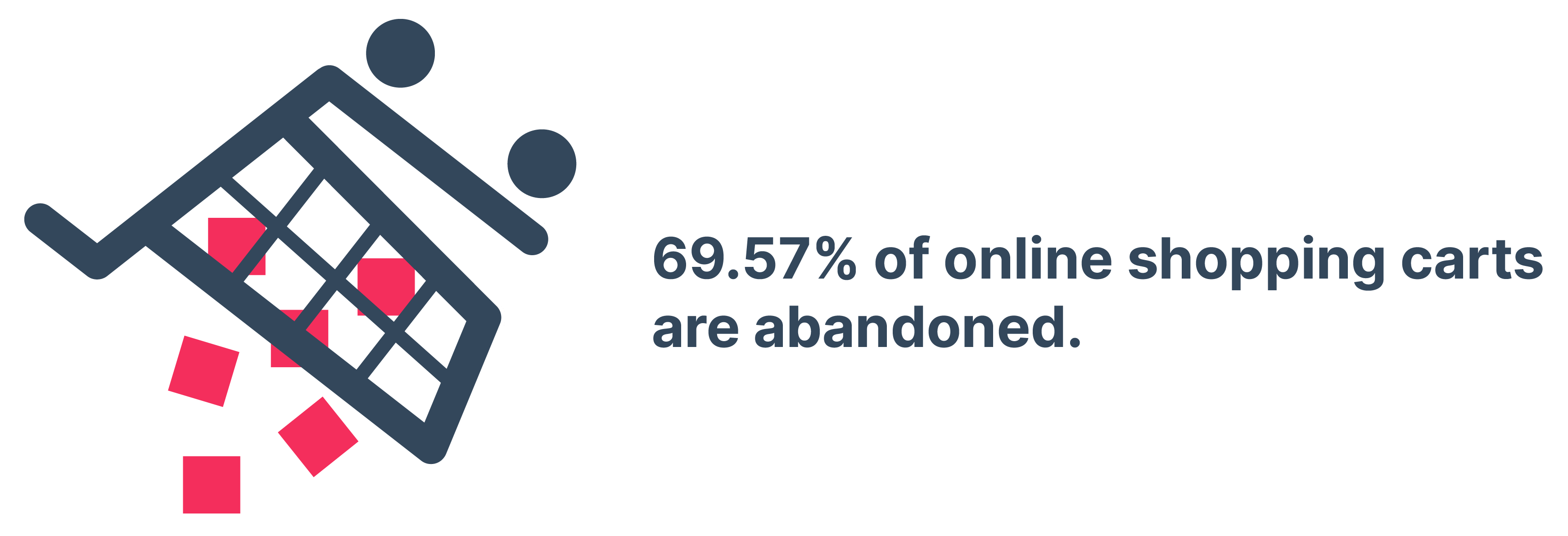Every industry has their own jargon, acronyms and technical terminology, and ecommerce is certainly no different. Whether you are just starting out or are a seasoned ecommerce professional, you will soon realise that ecommerce is a language within itself. This glossary of terms will help you keep up to date with the most important and most frequently used terms used by online vendors, suppliers, service providers and sellers.
A/B Testing
A/B testing is a method used to compare two separate variations of one webpage to determine which version performs best with visitors. Both variations of the page will be shown to different customers for a certain period of time, then one is selected based on the highest conversion rate, click through rate or revenue generated etc in that timeframe. This term can also apply to testing elements of email like subject line, send time, etc.
Above the fold
This is the space you first see on a web page when you land on it, before scrolling down. Any content that you need to scroll to see would be considered ‘below the fold’. Above the fold is where you want to position your most important graphics and copy to try and grab the attention of viewers.
Affiliate marketing
If you’ve ever seen a content creator or social media influencer showcasing a specific brand, then this is most likely affiliate marketing. A company will pay those individuals (or businesses) to promote their product or service. In return, the individual will get paid a flat rate or a percentage based commission from any purchases that occur directly as a result of that interaction.
Application programming interface (API)
APIs enable one platform, for example an ecommerce platform, to access features or data from another application, operating system or other service. It basically means they can ‘talk’ to one another, avoiding the need for developers to build code from scratch to integrate both applications.
Average order value (AOV)
This is the average spend from each customer on your ecommerce website. To calculate this figure, divide total sales revenue by the total number of orders. The higher the better with this value.
Business to business (B2B)
Business to business is a model that refers to the one company selling products or services to another. So Hurree is a B2B company, because we sell marketing analytics software to other businesses.
Business to consumer (B2C)
Business to consumer is the process of selling products or services direct from a company to the consumer. An example of this is Amazon, ASOS or Tesco.
Backlink
These are links on other websites that link directly to your page. The more of these you have from reputable websites, the better your site authority will be, allowing you to rank higher on search engines.
Bounce rate
This is the percentage of visitors who arrive on your site and then exit without taking any other action. The average ecommerce bounce rate is between 20% and 45%, with bounce rates lower than 20% being considered as exceptional.

Source: HotJar
Bundling
This is a strategy in which two or more products are bundled together and sold as a single unit for one price. It is used to encourage additional purchases and increase the average order value.
Buyer persona
A buyer persona is a fictionalised representation of your target audience based on existing data and market research. It includes characteristics such as behaviours, demographics, attitudes, needs and wants. It is used to help marketers create a more tailored and effective marketing strategy.
Call to action (CTA)
This is the visual instruction present on a webpage that encourages visitors to continue with their journey, whether it’s completing a purchase or completing a form. CTAs encourage conversion rate, examples include ‘Buy Now’, ‘Learn More’ or ‘Add to Cart’.
Cart abandonment
This is when a website visitor, i.e. a potential customer, adds items to their shopping cart, begins the check-out process and leaves without actually completing their purchase. Cart abandonment is one of the key issues fought by ecommerce teams today and is one of the biggest contributors to lost sales in the ecommerce industry.

Source: Shopify
Churn rate
This is the rate at which customers stop buying from your store during a specific time period. Having a high churn rate equals a low customer retention rate.

Click through rate (CTR)
The CTR measures the number of specific clicks on your page. It could be clicks on a specific link or button on the page. It is calculated by dividing the number of people who viewed the page with the amount of people who actually clicked.
Conversion rate
This is the amount of users who have done exactly what you wanted them to do - they have visited your website and made a purchase. The higher the conversion rate, the better.
Cookies
These are small text files stored in a web user's browser used to improve their shopping experience. It retains specific data on customers so that the experience is more seamless and personalised the next time that customer visits the website.
Cross-selling
Cross-selling is the marketing technique implemented by most ecommerce businesses to encourage customers to add additional items to their basket, often with complementary or closely related products. For example, if you were buying a shampoo, you might see a section or be notified by a pop up telling you ‘customers who bought this shampoo also bought this conditioner’, or you might see a frequently bought together section.
Customer acquisition cost (CAC)
This is the price a company pays for acquiring a customer. To calculate, divide the total cost of acquisition by the total new customers in a specific period of time. Looking at the CAC helps you determine whether your marketing strategies are working or need improvement.
Drop shipping
Drop shipping is a fulfilment method in which ecommerce companies don’t actually hold any physical inventory themselves. Instead they order stock directly from a third party supplier who will ship the product directly to the customer.
Fulfilment
This is literally the whole process of fulfilling ecommerce orders, from receiving an order to delivering it to the customer. Most ecommerce companies set specific time periods for fulfilment to ensure customers receive products within a given time frame.
Inventory
The actual physical amount of items or products a company has that are ready and available to sell. The goods are itemised and catalogued into an inventory management system to give full oversight of stock levels.
Keyword
This is a specific term for words that are used by customers to search online. Using the right keywords on web pages will help businesses rank better in search engines and ultimately get more traffic.
Key Performance Indicator (KPI)
KPIs are measurable values allowing businesses to track and analyse performance and progress towards an intended goal or objective over a certain period of time.
Further reading: The Essential Guide to KPIs
Landing page
The name is a slight give away. A landing page is a page your customers will land on after clicking a specific link. It should be designed in such a way that it encourages conversions, whether that’s a direct sale or completing a form.
Long-tail keyword
When a potential customer uses a more specific, targeted and usually longer phrase to search for a business, product or service.
Marketing automation
Marketing automation is the process of using technology and software to efficiently automate tasks and activities that would otherwise be done manually. The goal is to improve the entire customer experience, drive efficiency and improve overall productivity.

Source: Invesp
Minimum order quantity (MOQ)
This refers to the smallest number of products that a customer can buy at one time. This is more relevant for ecommerce businesses that sell high quantities of products, often at a lower price per unit. For example, branded items such as pens, notepads, USBs etc.
Minimum order value (MOV)
Similar to MOQ above, MOV refers to the smallest value that may be ordered in one transaction.
Monthly recurring revenue (MRR)
This is the total amount of income a company can expect to receive in an average month.
Net profit
Simply put, net profit is the net earnings or net income once expenses are paid. It includes the total revenue, minus the total expenses generated by the company. It’s crucial for ecommerce businesses to keep a close eye on this as a rise in revenue doesn’t always equal a rise in profits.
No follow link
To an average website visitor, these links look the same as regular links, however a no follow link is one that search engines will not crawl. They don’t actively influence search engine rankings and are essentially telling google that you do not endorse the link.
Omnichannel marketing
This is the marketing practice of creating a unified, seamless shopping experience for customers, no matter what device they are using, what channel they are on and at which stage of the customer journey they are at. An omnichannel approach ensures all messages, prices and prices are aligned across each touchpoint.
Organic traffic
This refers to the visitors who end up on your site that have come from an unpaid source. These sources include search engines like Google, Yahoo or Bing.
Partially shipped
This is when a single order is split across multiple deliveries. This is often required when one of the items is on backorder, it is being shipped from a different location or there is a delay in obtaining one of the items.
Pay per click (PPC)
The process of advertising where a company displays adverts on different websites and pages, with the goal of attracting new customers. The company will only pay when the ad is clicked and a customer visits their store.
Profit margin
This is defined as the difference between your sales revenue and the expenses and costs your business incurs. Profit margins are given as a percentage.

Source: Acquire Convert
Search engine optimisation (SEO)
This is the process where a specific set of practices is used to improve the authority and positioning of web pages in organic searches. A good SEO strategy is essential for improving the quality and quantity of traffic to your website.
Search engine results page (SERP)
When you search a word or query on a search engine like Google, the SERP is the list of results given to you. Search engines deliver this results page by analysing the search query and presenting the best possible matches using SEO.
Stock keeping unit (SKU)
Actually pronounced as ‘skew’, this is the unique identifier given to each product. It is used for stock and inventory management and usually consists of a mix of letters and numbers. One product may have multiple SKUs depending on the variety of colours, sizes and types, each variant with a different SKU.
Upsell
Upsell is the process of promoting a higher priced or upgraded version of a product to a customer. Say you had a 27 inch TV in your basket. An upsell for this would be a 32 inch TV with an extended warranty, at a higher price.
Winback
This is a type of lifecycle marketing campaign designed to re-engage and recapture inactive or former customers, encouraging them to make a repeat purchase. It is usually completed via an automated email flow that automatically sends to a customer after a certain period of inactivity from that customer.
This list is not exhaustive and we’re sure you will come across plenty more terms and acronyms, depending on your industry type or the ecommerce platform you are using. This glossary is a good place to start and will allow you to understand the basics. It might be useful to bookmark this page so you can access it easier in future if a term comes up that you are not familiar with.
Share this
You May Also Like
These Related Stories

Guide to Ecommerce Dashboards

8 of the Biggest Excel Mistakes of All Time



